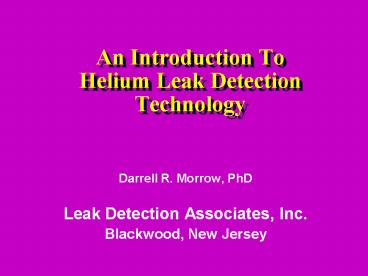An Introduction To Helium Leak Detection Technology - PowerPoint PPT Presentation
1 / 12
Title:
An Introduction To Helium Leak Detection Technology
Description:
An Introduction To Helium Leak Detection Technology Darrell R. Morrow, PhD Leak Detection Associates, Inc. Blackwood, New Jersey Why Helium? Low Background (5-20 PPM ... – PowerPoint PPT presentation
Number of Views:2451
Avg rating:3.0/5.0
Title: An Introduction To Helium Leak Detection Technology
1
An Introduction ToHelium Leak Detection
Technology
- Darrell R. Morrow, PhD
- Leak Detection Associates, Inc.
- Blackwood, New Jersey
2
Why Helium?
- Low Background (5-20 PPM)
- Inert
- Safe
- Light
- Low Cost
Ne
F
Ar
H
O
?
Kr
Cl
Xe
He
N
3
Why A Helium Leak Detector?
- High Sensitivity
- Wide Range
- Reliable
- Quantitative
- Dynamic Testing
- NIST Traceable
SIMS 180TD
4
Analyzer Cell180o Deflection
TRIODE PLATE
HEAVY IONS
HIGH VACUUM GAUGE
HELIUM IONS
LIGHT IONS
REPELLER
TARGET
200V VAR.
-
GROUND
HIGH POWER SUPPLY
RESISTANCE
MAGNET
FILAMENT
LOG AMPS
GROUND
5
Helium Test Methods Hard VacuumHelium
Pre-Filled Samples
1E-2 mbar
SIMS
180TD
6
Helium Leak Methods Sniffing Test
He
100 He
ALCATEL
SIMS 180TD
7
Helium Leak Testing Vacuum Mode
- The hard vacuum test procedure measures the
packages cumulative leak rate arising from all
sources within the sample. - This method enables the barrier performance of
seals to be quantified.
8
Helium Leak Testing Sniffer Mode
- Individual packages containing helium can be
checked for leaks using a pencil-sized vacuum
collector (sniffer) attached to a helium leak
detector. - The rate of gas sampling (flow rate) is set at
1cc/second enabling a (ambient pressure) leak
rate to be measured in ppm, or in cc/second. - The sniffer mode test procedure is
site-specific in that the probe collects helium
escaping within 1/8 of the leak site.
9
Virtual Leaks and Outgassing
Virtual leaks are small trapped volumes of gas at
atmospheric pressure within the vacuum envelope
which communicates with the vacuum system by
means of minute crevices, cracks, grooves, etc.
Outgassing is the desorption of atmospheric gases
and contamination from the surface area within
the vacuum system.
10
Fine Leak Rate Reality
Theoretical hole diameter calculation in
molecular flow regime
CONDITIONS 1E-6 atm cc/sec. He
leak rate 0.6 cm. wall thickness 20 C ambient
temperature Inboard He spray test
D 4
(.6)(1)(6E-6) 0.33 2
(8.32E7)(293)
D .0009 cm. 0.9 microns
Size (microns) .0001 .001 .01
.1 1 10 100
1,000 10,000
Pollen
Microbes
1 meter 1,000,000 microns
Lint
Tobacco smoke
Finger prints
Household dust
Alcohol residue
Industrial dust
Acid fumes
Gas molecules
11
Pharmaceutical/Device Package Test Methods
- Leak Test Methods Principles
- The most common concept behind the rapid
detection of leaks in various packaging forms is
the monitoring of changes in specific physical
parameters such as fluid (gas/vapor/liquid)
transport from one side of a sealed package
to the other, such as bubble formation or
pressure changes.
12
Pharmaceutical/Device Package Test Methods
- Existing Test Methods
- Bubble Generation Test - Vacuum (ASTM D 3078-94)
- Bubble Generation Test - Internal Pressurization
(ASTM F 515-95) - Pressure Decay Test
- Dye Penetration Test
- Tracer Gas Leak Detection Test/s - Helium,
Oxygen, Argon, CO2































